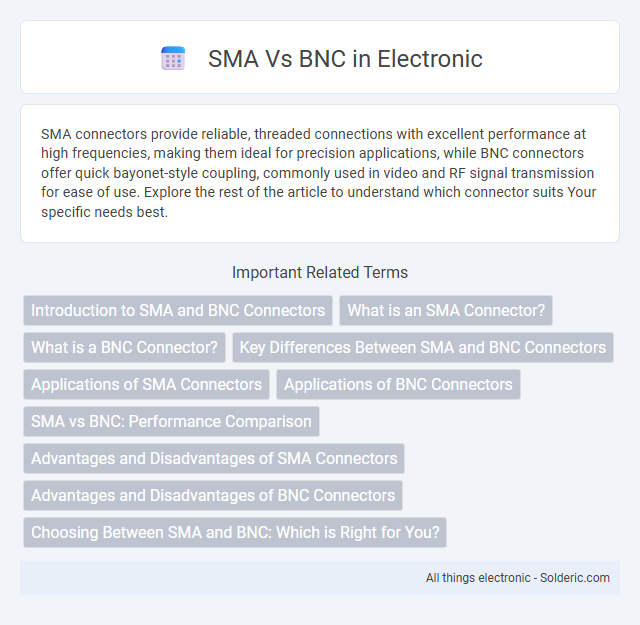SMA connectors provide reliable, threaded connections with excellent performance at high frequencies, making them ideal for precision applications, while BNC connectors offer quick bayonet-style coupling, commonly used in video and RF signal transmission for ease of use. Explore the rest of the article to understand which connector suits Your specific needs best.
Comparison Table
| Feature | SMA (Shape Memory Alloy) | BNC (Boron Nitride Ceramic) |
|---|---|---|
| Material Type | Metallic alloy (Nickel-Titanium) | Ceramic compound (Hexagonal Boron Nitride) |
| Key Properties | Shape memory effect, superelasticity, corrosion resistance | High thermal stability, electrical insulation, lubricity |
| Temperature Resistance | Up to 100degC - 200degC typically | Up to 900degC - 1000degC |
| Electrical Conductivity | Conductive | Electrical insulator |
| Mechanical Strength | High tensile strength with flexibility | High compressive strength but brittle |
| Applications | Medical devices, actuators, robotics, aerospace | High-temperature insulators, lubricants, electronics |
| Cost | Moderate to high | Moderate |
Introduction to SMA and BNC Connectors
SMA connectors are precision coaxial connectors designed for high-frequency applications up to 18 GHz, providing excellent performance in RF and microwave systems. BNC connectors, on the other hand, are bayonet-style connectors commonly used for video, radio, and test equipment with frequencies up to 4 GHz. Understanding the differences between SMA and BNC connectors helps you select the right type for your specific signal and frequency requirements.
What is an SMA Connector?
An SMA connector is a precision coaxial RF connector designed for high-frequency signal transmission up to 18 GHz, commonly used in microwave systems, antennas, and RF instrumentation. Its threaded interface ensures a secure and reliable connection, minimizing signal loss and reflections for optimal performance. Choosing SMA connectors for your setup provides durability and excellent impedance matching in compact applications.
What is a BNC Connector?
A BNC connector, or Bayonet Neill-Concelman connector, is a miniature quick connect/disconnect RF connector used primarily for coaxial cable. It is widely used in television, radio, and other radio-frequency electronic equipment due to its reliable, easy-to-use bayonet locking mechanism. The BNC connector supports frequencies up to 4 GHz and provides a secure connection with minimal signal loss, making it ideal for professional video and networking applications.
Key Differences Between SMA and BNC Connectors
SMA connectors feature a threaded coupling mechanism providing superior durability and high-frequency performance, typically up to 18 GHz, while BNC connectors use a bayonet locking system suitable for frequencies up to 4 GHz. SMA connectors are preferred for applications requiring precise RF signal transmission and minimal signal loss, whereas BNC connectors are commonly used in audio, video, and low-frequency networking due to their ease of use. Your choice depends on the required frequency range, mechanical stability, and application environment.
Applications of SMA Connectors
SMA connectors are widely used in applications requiring precise, high-frequency signal transmission such as microwave systems, antennas, and RF test equipment due to their excellent performance up to 18 GHz. Their robust threading mechanism ensures secure connections in aerospace, telecommunications, and military communications where durability is critical. You can rely on SMA connectors for reliable operation in demanding environments, especially when compared to BNC connectors, which are typically suited for lower-frequency video and networking signals.
Applications of BNC Connectors
BNC connectors are widely used in radio frequency, video, and networking applications due to their reliable quick connect/disconnect design and frequency handling up to 4 GHz. They commonly appear in test equipment, RF signal connections, and CCTV camera systems, offering secure and low-loss signal transmission. Their compatibility with coaxial cables makes them essential in broadcast, telecommunications, and instrumentation setups.
SMA vs BNC: Performance Comparison
SMA connectors offer superior performance with higher frequency handling up to 18 GHz and better signal integrity compared to BNC connectors, which are typically limited to 4 GHz applications. The threaded design of SMA connectors ensures a more secure and stable connection, reducing signal loss and improving reliability in high-frequency environments. You should choose SMA connectors for precision RF applications requiring consistent impedance and minimal signal degradation, while BNC connectors remain suitable for lower-frequency or quick-connect needs.
Advantages and Disadvantages of SMA Connectors
SMA connectors offer superior frequency performance up to 18 GHz, making them ideal for microwave applications and high-frequency signals compared to BNC connectors, which typically operate below 4 GHz. Their threaded coupling provides a secure, vibration-resistant connection, enhancing reliability in rugged environments, whereas BNC connectors use a bayonet coupling that is quicker to connect but less secure. However, SMA connectors are generally more expensive and require careful handling to avoid damage, while BNC connectors are more user-friendly and cost-effective for lower-frequency, general-purpose use.
Advantages and Disadvantages of BNC Connectors
BNC connectors offer quick and reliable connections for RF signals, supporting frequencies up to 4 GHz, making them ideal for video and radio applications. Their bayonet locking mechanism ensures secure attachment, preventing signal loss and noise interference compared to SMA connectors, which require precise threading. However, BNC connectors are generally bulkier and less suitable for high-frequency microwave applications above 4 GHz, where SMA connectors perform better due to their superior impedance stability and minimal signal reflection.
Choosing Between SMA and BNC: Which is Right for You?
Choosing between SMA and BNC connectors depends on your specific application requirements; SMA connectors offer superior frequency performance up to 18 GHz, making them ideal for high-frequency RF and microwave communications. BNC connectors excel in ease of use and quick connection for frequencies up to 4 GHz, commonly used in video, audio, and test instruments. Your decision should consider frequency range, mechanical durability, and the need for quick or secure connections to ensure optimal system performance.
SMA vs BNC Infographic

 solderic.com
solderic.com